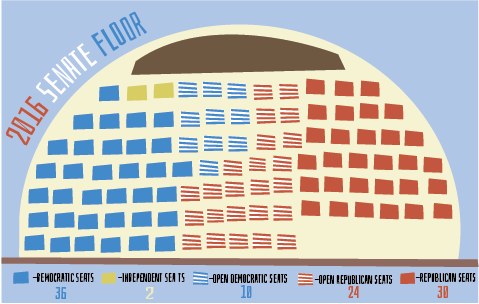There are 469 seats in the U.S. Congress up for election on Nov. 8, 2016. That includes 34 Senate seats and all 435 seats in the House of Representatives.
Much of the media covering the 2016 congressional election cycle, such as the Wall Street Journal and the New York Times, are focusing on which party will regain control of the Senate. Of the Senate seats not up for election, 34 are held by Democrats, 30 are held by Republicans and two are held by Independents that caucus with the Democrats. Republicans currently hold 24 of the 34 Senate seats up for election, while Democrats hold only 10, and 51 of the 100 seats are needed to have majority.
The Wall Street Journal published an article online on Aug. 11, 2016 claiming that Democrats have a higher chance of winning the minimum five net seats necessary to gain control of the Senate. The article also said that if Democrats keep the White House, they would only need four additional seats as the vice president is able to break a 50-50 tie in the Senate. It has been nearly two months since this article was published and already the predictions have shifted.
The New York Times online reported that as of Sept. 26, 2016, Republicans have a 64 percent chance of winning the Senate, the exact percentage Democrats reportedly had on Aug. 11. The Wall Street Journal and New York Times both highlighted Florida, Indiana, Nevada, New Hampshire, North Carolina and Pennsylvania as influential races to watch.
Junior political science major William Jackson said he believes the presidential election has and will continue to have a major effect on the outcome of the Senate and House elections.
“This year isn’t very traditional because of how radically different Donald Trump is from the usual Republican candidate,” Jackson said. “But I think a lot of conservatives are really angry right now. Along with the anti-establishment fuel from Trump, I feel like that’s going to make a lot of conservatives want to go out and vote whereas Democrats might feel less energized to be involved.”
Arkansas voters will elect one member to the U.S. Senate. According to a poll published Sept. 15 by Emerson College, GOP Senator John Boozman has a 14-point edge over Democrat Conner Eldridge, 44 percent to 30 percent. Boozman will not only face Eldridge in the general election, but Libertarian candidate Frank Gilbert and write-in candidate Jason Tate as well.
While all 435 seats in the House of Representatives are up for election, all but 43 representatives are seeking re-election. In order to gain control of the chamber, the Democratic Party would have to get an additional 30 seats. Two hundred and eighteen seats are needed for a party to hold majority in the House and, according to Ballotpedia, Republicans currently hold their largest majority in the U.S. House since 1928. There are currently 246 seats held by Republicans and 186 seats held by Democrats, as well as three vacancies.
